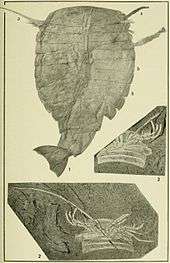Sidneyia
| Sidneyia Temporal range: Burgess Shale | |
|---|---|
| | |
| Reconstruction of Sidneyia | |
| Scientific classification | |
| Kingdom: | Animalia |
| Phylum: | Arthropoda |
| Class: | Merostomoidea† |
| Order: | Limulavida |
| Genus: | Sidneyia Walcott, 1911 |
| Species: | S. inexpectans |
| Binomial name | |
| Sidneyia inexpectans Walcott, 1911 | |
Sidneyia is an extinct arthropod known from fossils found in the Cambrian-age Burgess Shale formation of British Columbia. 144 specimens of Sidneyia are known from the Greater Phyllopod bed, where they comprise 0.27% of the community.[1]
General description

Sidneyia ranged from 2 to 5 inches (51 to 127 mm) in length and is one of the largest arthropods found at the site. It is thought to have been a benthic carnivore that walked along the sea floor in search of hard-shelled prey. Gut contents have revealed that Sidneyia fed on hyolithids (molluscs) and other small crustaceans and trilobites.
Sidneyia was discovered in 1910 during the first day of Charles Walcott's exploration of the Burgess Shale. He named it after his elder son, Sidney, who had helped to locate the site and collect the specimen. The species name, Sidneyia inexpectans, means "Sidney's discovery".
About 200 specimens have been documented.
External links
- "Sidneyia inexpectans". Burgess Shale Fossil Gallery. Virtual Museum of Canada. 2011.
References
- ↑ Caron, Jean-Bernard; Jackson, Donald A. (October 2006). "Taphonomy of the Greater Phyllopod Bed community, Burgess Shale". PALAIOS. 21 (5): 451–65. doi:10.2110/palo.2003.P05-070R. JSTOR 20173022.
Further reading
- C. L. Bruton (1981). "The arthropod Sidneyia inexpectans, Middle Cambrian, Burgess Shale, British Columbia". Philosophical Transactions of the Royal Society B: Biological Sciences. 295 (1079): 619–653. Bibcode:1981RSPTB.295..619B. doi:10.1098/rstb.1981.0164.